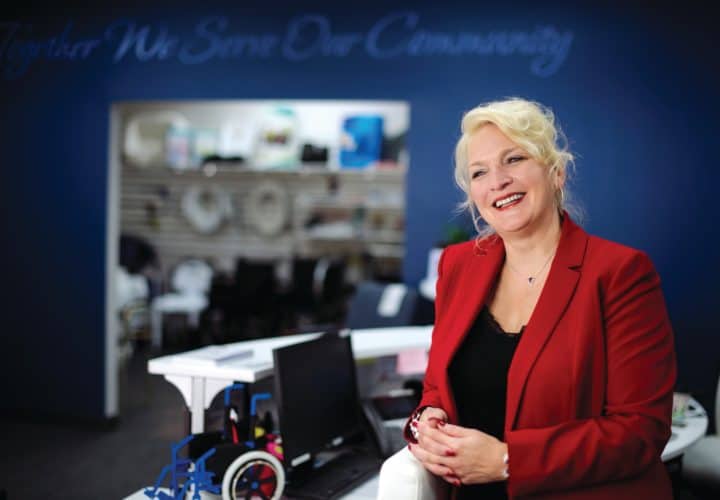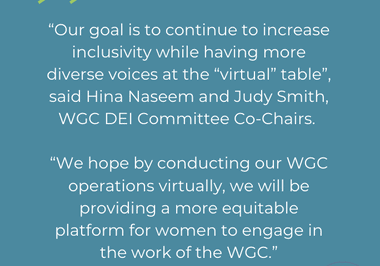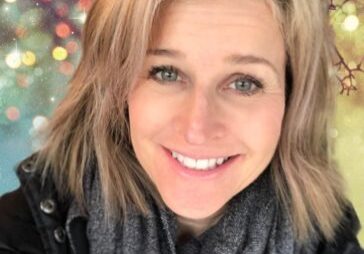When it comes to aging, Mary Becker wants you to feel at home
Interview BY Martha Thomas Portrait BY Mary C. Gardella
November/December 2017
As the aging in place manager for the Howard County Office on Aging and Independence, Mary Becker helps to ensure that older adults have access
to the services they need to remain safely in their homes. Becker, who studied psychology in college and has a master’s degree in occupational therapy,
Q How is the Loan Closet integrated into other services?
When people are aging and something changes, the first stop is the medical system. The medical system is very defined and linear. They tell you what to do, you go to the lab, you get your X-rays, you get your prescriptions. When you get back into the community, you don’t have a system where you walk in and someone says do this, do this, do this. Aging services are very fragmented. Making a transition from medical to community services can be very confusing.
People come to the Loan Closet because they’ve had a change in circumstances or mobility. They’re looking for a piece of durable medical equipment like a wheelchair or a walker or a cane. We might be in a position to refer them to other services.
People have questions about how they are going to get around. We have an education center that can talk about home modifications universal design and provide consultations—onsite or at the Loan Closet so people can remain in the home and in the community.
Q Research has shown that the majority of aging adults want to remain at home.
The AARP numbers are now at about 85 percent. It’s becoming a financial necessity too. The challenge comes when there is some functional change. People have a tendency to adapt to their environments, rather than adapting their environments to them, and they’ll do that until something significant happens—usually there’s an injury, or a disease progresses so they can’t do basic things. My checklist for remaining in the home is: if you can get into and out of your home, use your bathroom, go level to level within your home, and if you have cognitive abilities to manage your medications and respond in an emergencies. But if something happens that impacts one of those things it can be a deciding factor.
Q Aren’t some people thrilled to move into retirement communities?
People say they want to stay in their homes, but they don’t think about how nice it would be to live in a senior apartment complex with people who share interests and provide more social opportunities. Usually they’ll meet a peer and learn of their experience, that they’ve made this move and they’re so happy. Initially, at the pre-contemplation stage, they’ll say I’m going to stay here for life, and then someone asks them if they’ve heard about this senior apartment complex. Then they might visit someone … there are many steps to the process. Our target is helping people at all those stages.
Q How do you deal with isolation?
There are many answers, depending on the client. You need to find out where people are, what their past history is. For some, being alone is what they’ve done all their lives; you don’t want to suddenly expect them to be social. Some people might thrive on all the activities of a 50-plus center, others might need to get connected with Pets on Wheels or another program that can engage with them one-on-one.
Q All the Columbia pioneers who came here in their 20s and 30s as part of this social experiment are now in their 70s and 80s. Does their sense of community mean higher expectations as they age?
In Howard County, we have a highly educated population, higher income and individuals who have higher expectations. I can’t say it has to do with the early adopters of Columbia. You have to remember we’re one of the wealthiest communities in the U.S., and because of this, Howard County brings a variety of services that a lot of counties don’t have.
Q And these services are also available for low income individuals?
If you happen to be low income and aging in Howard County, you’re really lucky. You have to keep in mind that when you’re looking at aging services, you have multiple levels. We’re at a government level and our function is to provide basic services for those who have the greatest need. For higher income it’s more about being a resource for people who can use their means to make decisions for themselves.
Q How did you come to the field of aging services?
It was not by accident. My maternal grandmother lived alone in her home on $350 per month. She didn’t even receive medical care and died in a very sad situation because our family didn’t know what to do. As I went through school and learned about all the services that were available, I became determined that no one would have to experience the end of life like my grandmother. The quality of her life was so poor and could have been so much better, if our family had known about resources available.
Q You sound like the founder of AARP.
The one who found the woman living in the chicken coop. My grandmother literally—and this is a little gross—put her colon back into her body every time she went to the bathroom because she didn’t have the money to get medical care. She didn’t pay her Medicare Part B because she needed the $30 a month for other things. Before she died, she had ulcers on the bottoms of her feet and would stain the floor when she walked.
QHow did you come to be so involved in home modifications?
I lived for a while in a 55-plus community, Snowden Overlook. I was doing intergenerational living with in-laws; my father-in-law was quite ill and I wanted to create a home where we could provide nursing home-style care. I was one of the original residents and insisted on universal design features. I had them install one of the first no-step entries, continuous handrails—all had to be modified from the original plans.
Q Did that help redirect design in the complex?
Builders will do things when people request and pay for them. I managed to get my no-step entry, but the real change for builders comes from licensing and permits. Professionally, I was involved in making sure we put regulations in place.
Q What other regulations might help with aging in place?
The next thing I want to address at a county level is allowing accessory apartments for single-family homes, so you can create another space for adult children or caregivers to live. In some places, zoning doesn’t allow what they call a multi-family dwelling. You couldn’t put in a second kitchen. I ran into this with my own family. If you have a 55-plus home that’s 5,000 square feet, you should be able to adapt it to have family members or a caregiver live there. That solves a couple of problems by also creating affordable housing for caregivers. When you think of the workforce that provides care in the home—our region doesn’t necessarily have housing available for that income level.
Dividing up homes may work for younger families who might not want those huge houses.
Intergenerational living is on the rise, so our housing stock needs to accommodate it. I’m currently living inter-generationally— I’ve been divorced, and I’m now remarried and in the same situation. My in-laws have a home in Florida and they come up here and want to be with their family. They enjoy the hubbub of the family coming and going, so I’m back in the same situation. *




